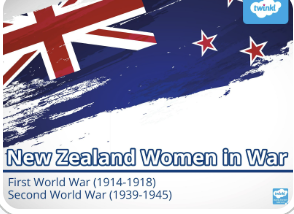24 June - 30 June
Section outline
-
EXPLORE / TŪHURA learning intentions:
- We are ANALYSING the impact of war on New Zealand society, focusing on the changing roles of women.
- We are RESEARCHING and IDENTIFYING the different contributions of NZ women during wartime.
- We are EVALUATING the significance of these contributions to the war effort.
- We are COMPARING and CONTRASTING the experiences of women on the home front and in active service.

New Zealand Women in War
Learning Objectives
Students will analyze the impact of war on New Zealand society, focusing on the changing roles of women.
Students will research and identify the different contributions of NZ women during wartime.
Students will evaluate the significance of these contributions to the war effort.
Students will compare and contrast the experiences of women on the home front and in active service.
Students will develop research and critical thinking skills through inquiry-based learning.
Lesson 1: Introduction: Beyond the Trenches
Do Now: Brainstorm what students know about the role of women in war.
Introduction: Discuss the traditional focus on soldiers in wartime narratives.
Shifting the Focus: Introduce the concept of the "home front" and the vital contributions of women during wartime.
Source Analysis: Analyze primary and secondary sources (e.g., photos, diary entries, news articles) depicting the experiences of NZ women in WWI or WWII.
Questions to Consider: What jobs did women take on? How did the war impact their daily lives? What evidence suggests their contributions were significant?
Exit Ticket: Briefly write about one way the war might have changed the lives of women in New Zealand.
Lesson 2: Roles on the Home Front
Do Now: Briefly review the concept of the home front and its importance during wartime.
Research Groups: Divide students into groups and assign each group a specific role NZ women played on the home front during WWI or WWII (e.g., nurses, factory workers, farmers).
Group Research: Students research their assigned role using provided resources (books, websites, documentaries). They will focus on the responsibilities, challenges, and impact of these women's contributions.
Group Presentations: Each group presents their findings to the class, highlighting key points and using visuals if available.
Lesson 3: Beyond the Home Front
Do Now: Briefly review the different roles women played on the home front.
Expanding the Narrative: Discuss the lesser-known stories of NZ women who served overseas in various capacities (e.g., nurses, drivers, entertainers).
Case Studies: Present case studies of individual NZ women who served overseas during wartime. Students analyze primary sources (letters, diaries) to understand their experiences and motivations.
Class Discussion: Facilitate a class discussion about the challenges and contributions of these women. How did their experiences differ from those on the home front?
Lesson 4: Legacy and Significance
Do Now: Briefly review the different roles NZ women played during wartime.
Long-Term Impact: Discuss the long-term impact of the war on NZ society, particularly regarding women's rights and opportunities. How did the war contribute to social change?
Commemoration: Explore memorials and commemorative events that acknowledge the contributions of NZ women in war.
Creative Project: Students choose a creative format (e.g., poem, poster, short video) to represent the significance of NZ women's wartime contributions.
Gallery Walk: Students share their creative projects in a gallery walk format, allowing for peer feedback and appreciation.
